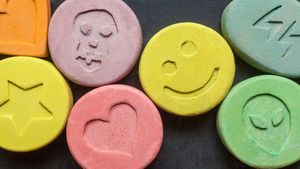MDMA
MDMA, commonly known as ecstasy or Molly, is a synthetic drug that induces both amphetamine-like stimulation and mild hallucinations. MDMA has demonstrated efficacy of in treating PTSD, it is thought by a process known as fear memory extinction.
Clinical Dosage
Dosage is performed in the following stages...[1]
1. Recruitment and medical screening. Start tapering of other medicines if needed.
2. Prep sessions 1 and spaced over 2 weeks.
3. 3rd preparation session. Finish tapering off medications.
4. 1st MDMA assisted session 80mg + 40 mg booster dose.
5. 3 week break with a 90-minute integration session each week.
6. 2nd MDMA session 80mg or 120mg plus half dose booster.
7. 3 week break with a 90-minute integration session each week.
8. 3rd MDMA session 80mg or 120mg plus half dose booster.
9. Last, 3 week break with a 90-minute integration session each week.
10. Final integration session.
Mechanism of Action
The mechanism of action involves a decrease in activity within the limbic system, a group of structures responsible for emotional responses. Furthermore, there is a reduction in communication between the medial temporal lobe and the medial prefrontal cortex, which play roles in emotional control. Collectively, these effects are contrary to the patterns observed in individuals experiencing anxiety.[2][3]
Effects
When taken orally, MDMA starts to take effect in about 30 to 45 minutes, with its impact lasting between three to six hours. This medication offers a gentler experience compared to psychedelics and is known to foster feelings of empathy.
MDMA aids in enhancing understanding and management of emotions and coping mechanisms, primarily by augmenting fear extinction. This results in a changed perspective and better processing of traumatic memories. Furthermore, MDMA can modulate fear memory reconsolidation, potentially through effects on oxytocin, and improve social behaviors, as observed in animal studies.
MDMA can aid sexual relationships
It is likely that MDMA increases sexual desire and intensifies orgasm and that dose, ‘set and setting’, and timing relative to MDMA administration make major differences in ability of men to achieve the erectile quality necessary for ejaculation[4].
MDMA has a stronger effect in women
Women are more affected by MDMA's psychoactive effects than males[5]. Women especially have greater perceptual changes, thought disturbances, and fear of loss of body control. In addition, acute adverse effects and sequelae were also more frequent in female than in male subjects. In contrast, men showed higher increases in blood pressure than women.
MDMA Comedown
There is a wide amount of anecdotal evidence and some scientific evidence[6][7] to suggest that after using MDMA there is an emotional comedown reported colloquially as "Blue Mondays". However, a recent, low powered study found that there was little evidence for this[8].
Coadministration
It is thought that the effects of MDMA might be further potentiated by administration with psilocybin termed a hippie flip[9]. Therapeutically, MDMA is often used first in order to build the therapeutic alliance and increase the patient’s openness to change, leading to enhanced resilience and lowered stress levels. Once further changes were noticed, such as improved self-regulation, less negative self-perception, and increased tolerance to trauma exposure, a psychedelic such as psilocybin was introduced to assist psychotherapy. The deepening of the therapeutic process led to improvement per clinical judgment, without adverse events.[10]
References
- ↑ MDMA-assisted therapy for moderate to severe PTSD: a randomized, placebo-controlled phase 3 trial, Jennifer M. Mitchell, Published: 14 September 2023, accessed 4 Dec via https://www.nature.com/articles/s41591-023-02565-4
- ↑ 3,4-Methylenedioxymethamphetamine (MDMA) impairs the extinction and reconsolidation of fear memory in rats. Hake, H. S. et al. Physiol. Behav. 199, 343–350 (2019). http://scholar.google.com/scholar_lookup?&title=3%2C4-Methylenedioxymethamphetamine%20%28MDMA%29%20impairs%20the%20extinction%20and%20reconsolidation%20of%20fear%20memory%20in%20rats&journal=Physiol.%20Behav.&doi=10.1016%2Fj.physbeh.2018.12.007&volume=199&pages=343-350&publication_year=2019&author=Hake%2CHS
- ↑ Oxytocin-dependent reopening of a social reward learning critical period with MDMA. Nardou, R. et al. Nature 569, 116–120 (2019). https://doi.org/10.1038%2Fs41586-019-1075-9
- ↑ Does MDMA have treatment potential in sexual dysfunction? A systematic review of outcomes across the female and male sexual response cycles. Wexler A, Dubinskaya A, Suyama J, Komisaruk BR, Anger J, Eilber K.. Sex Med Rev. 2023 Oct 26:qead046. doi: 10.1093/sxmrev/qead046. Epub ahead of print. PMID: 37888490.
- ↑ Gender differences in the subjective effects of MDMA. Psychopharmacology (Berl). Liechti ME, Gamma A, Vollenweider FX. 2001 Mar 1;154(2):161-8. doi: 10.1007/s002130000648. PMID: 11314678. Accessed on 10 May 2023 via: https://pubmed.ncbi.nlm.nih.gov/11314678/
- ↑ Safety pharmacology of acute MDMA administration in healthy subjects. J Psychopharmacol 31: 576–588. Vizeli P, Liechti ME. (2017) Accessed on 20 Nov 2023 via https://pubmed.ncbi.nlm.nih.gov/28443695/
- ↑ Gender differences in the subjective effects of MDMA. Liechti ME, Gamma A, Vollenweider FX. (2001) Psychopharmacology 154: 161–168. Accessed on 20 Nov 2023: https://pubmed.ncbi.nlm.nih.gov/11314678/
- ↑ Debunking the myth of 'Blue Mondays': No evidence of affect drop after taking clinical MDMA. J Psychopharmacol. 2022 Mar;36(3):360-367. doi: 10.1177/02698811211055809. Epub 2021 Dec 13. . Ben Sessa, Jacob S Aday, Steve O'Brien, H Valerie Curran, Fiona Measham, Laurie Higbed, David J Nutt. https://pubmed.ncbi.nlm.nih.gov/34894842/
- ↑ Co-use of MDMA with psilocybin/LSD may buffer against challenging experiences and enhance positive experiences. Zeifman, R. J., Kettner, H., Pagni, B. A., Mallard, A., Roberts, D. E., Erritzoe, D., Ross, S., & L., R. (2023). Scientific Reports, 13(1), 1-11. https://doi.org/10.1038/s41598-023-40856-5
- ↑ Therapeutic role of psilocybin and 3,4-methylenedioxymethamphetamine in trauma: A literature review. Fonseka LN, Woo BK. World J Psychiatry. 2023 May 19;13(5):182-190. doi: 10.5498/wjp.v13.i5.182. PMID: 37303932; PMCID: PMC10251361.
